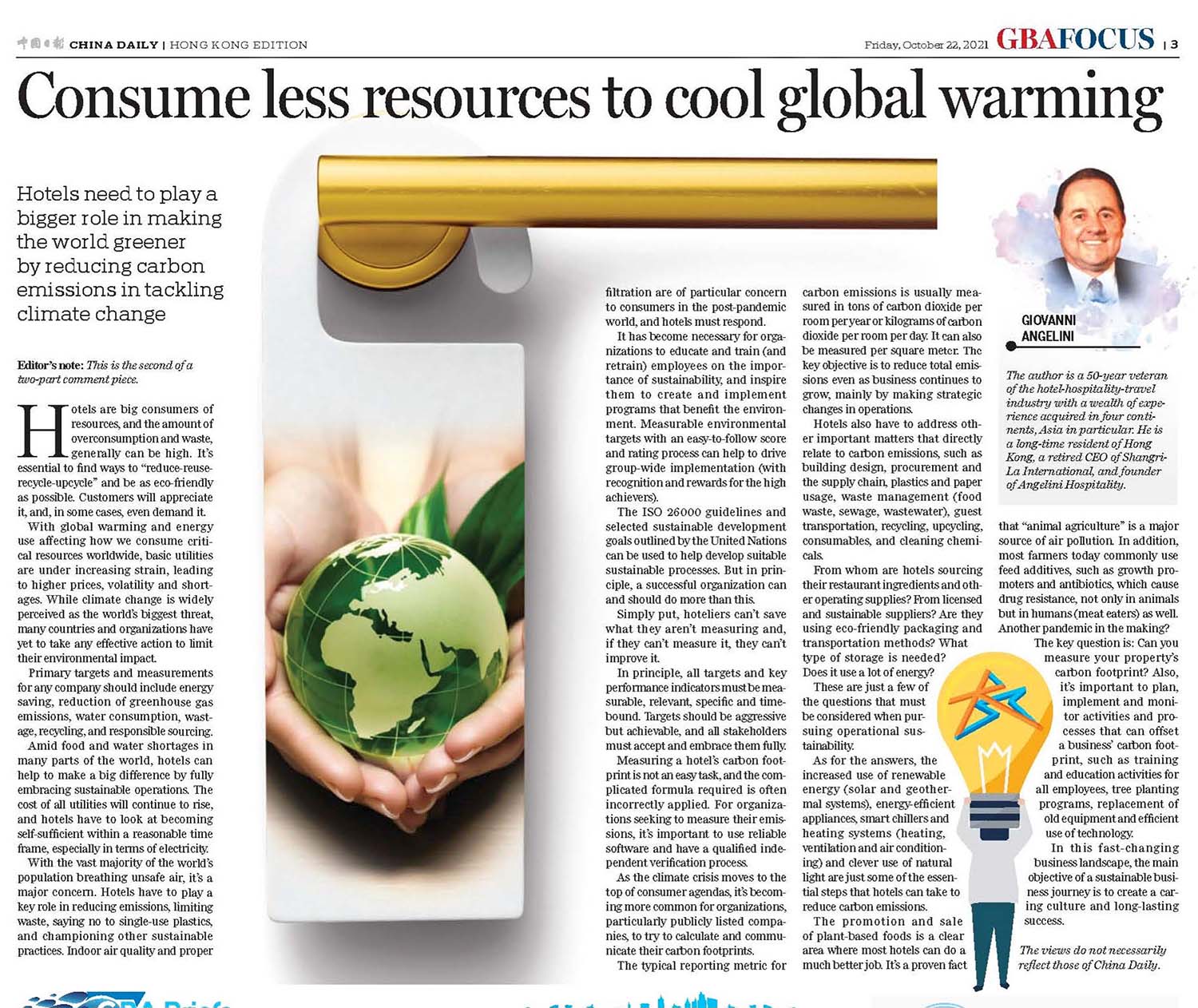(Article by China Daily, Hong Kong, Oct 2021)
Hotels need to play a bigger role in making the world greener by reducing carbon emissions in tackling climate change
Editor’s note: This is the second ofa two-pcm comment piece.
Hotels are big consumers of resources and the amount of overconsumption and waste, generally can be high. It’s essential to find ways to “reduce-reuserecycle-upcycle” and be as eco-friendly as possible. Customers Mill appreciate it, and, in some cases even demand it.
With global warming and energy use affecting how we consume critical resources worldwide, basic utilities are under increasing strain, leading to higher prices, volatility and shortages. While climate change is widely perceived as the world’s biggest threat, many countries and organizations have yet to take any effective action to limit their environmental impact.
Primary targets and measurements for any company should include energy saving, reduction of greenhouse gas emissions, water consumption, wastage, recycling, and responsible sourcing.
Amid food and water shortages in many parts of the world, hotels can help to make a big difference by fully embracing sustainable operations. The cost of all utilities will continue to rise, and hotels have to look at becoming self-sufficient within a reasonable time frame, especially in terms of electricity.
With the vast majority of the world’s population breathing unsafe air, it’s a major concern. Hotels have to play a key role in reducing emissions limiting waste, saying no to single-use plastics, and championing other sustainable practices. Indoor air quality and proper filtration are of particular concern to consumers in the post-pandemic world, and hotels must respond.
It has become necessary for organizations to educate and train (and retrain) employees on the importance of sustainability, and inspire them to create and implement programs that benefit the environment. Measurable environmental targets with an easy-to-follow score and rating process can help to drive group-wide implementation (with recognition and rewards for the high achievers).
The ISO 26000 guidelines and selected sustainable development goals outlined by the United Nations can be used to help develop suitable sustainable processes. But in principle, a successful organization can and should do more than this
Simply put, hoteliers can’t save What they aren’t measuring and, if they can’t measure it, they can’t improve it.
In principle, all targets and key performance indicators must be measurable, relevant, specific and timebound. Targets should be aggressive but achievable, and all stakeholders must accept and embrace them fully.
Measuring a hotel’s carbon footprint is not an easy task, and the complicated formula required is often incorrectly applied. For organizations seeking to measure their emissions, it’s important to use reliable software and have a qualified independent verification process
As the climate crisis moves to the top of consumer agendas it’s becoming more common for organizations, particularly publicly listed companies, to try to calculate and communicate their carbon footprints.
The typical reporting metric for carbon emissions is usually measured in tons of carbon dioxide per room per year or kilograms of carbon dioxide per room per day. It can also be measured per square meter. The key objective is to reduce total emissions even as business continues to grow, mainly by making strategic changes in operations.
Hotels also have to address other important matters that directly relate to carbon emissions, such as building design, procurement and the supply chain plastics and paper usage, waste management (food waste, sewage, wastewater), guest transportation, recycling, upcycling, consumables, and cleaning chemicals
From whom are hotels sourcing their restaurant ingredients and other operating supplies? From licensed and sustainable suppliers? Are they using eco-friendly packaging and transportation methods? What type of storage is needed? Does it use a lot of energy?
These are just a few of the questions that must be considered when pursuing operational sustainability.
As for the answers, the increased use of renewable energy (solar and geothermal systems), energy-efficient appliances smart chillers and heating systems (heating, ventilation and air conditioning) and clever use of natural light are just some of the essential steps that hotels can take to reduce carbon emissions.
The promotion and sale of plant-based foods is a clear area where most hotels can do a much better job. It’s a proven fact that “animal agriculture” is a major source of air pollution In additions most farmers today commonly use feed additives such as growth promoters and antibiotics which cause drug resistance, not only in animals but in humans (meat eaters) as well. Another pandemic in the making?
The key question is: Can you measure your property’s carbon footprint? Also, it’s important to plan, implement and monitor activities and processes that can offset a business’ carbon footprint, such as training and education activities for all employees, tree planting programs, replacement of old equipment and efficient use of technology.
In this fast-changing business landscape, the main objective of a sustainable business journey is to create a caring culture and long-lasting success.
The views do not necessarily reflect those of China Daily.
ABOUT GIOVANNI ANGELINI
The author is 50-year veteran of the hotel-hospitality-travel industry with wealth of experience acquired in four continents, Asia in particular. He is a long-time resident of Hong Kong, a retired CEO of Shangri-La International, and founder of Angelini Hospitality.

